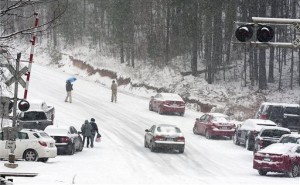Everyone has been battling the blasts of icy winds when making their way across campus, and no one could be wrong in saying that the definite feeling this winter is summed up by one word: frozen.
Earlier this month, the Northwest experienced record-low temperatures. Schools were shut down in both Minnesota and Chicago, and driving was banned in Indianapolis because of the skin-freezing wind chills and dangerous road conditions from heavy snowfall. Winter Storm Leon left hundreds of drivers down in Atlanta helpless because of a massive gridlock.

However, this winter, by comparison, might not be as chilly as you think. According to a study by Time, temperatures for January for the 10 largest U.S. cities have been close to or even surpassing the historical average highs for those areas. This surprising data begs the question: why have we been bundling up for such a sensational cold snap this year, meanwhile meteorologists are recording historically higher temperatures?
The more shivery and numb we might feel actually may indicate the nuanced effects of climate change. Monday, Jan. 6, was the first time in 20 years that average temperatures across the nation leveled at below 18 degrees. What felt like alarming temperatures this month were normal to us just four years ago. Weather patterns have certainly changed, and by adapting to this, studies show our warped perception of the weather will continue to surface when what was once typical winter weather leaves us shaking and trembling.
This changed feeling has been coined by Daniel Pauly, the result of “shifting baselines.” In studying the effects that overfishing has on the ocean and the misleading, healthy looking appearance of Caribbean waters and reefs, Pauly asserts that, “We transform the world, but we don’t remember it. We adjust our baseline to the new level, and we don’t recall what was there.”
Similarly, our “baseline” of what weather should feel like to us has been radically altered because of persistent climate change.
Not all of America has been bearing the “big freeze.” A severe drought has plagued California for months and continues into this year. 2013 was the driest year ever recorded for the state, and the lack of rainfall has serious implications. Officials predict that within three to four months, several lower-income communities will be without water if the dry times continue. Agricultural leaders and other small farmers are expecting stark setbacks in their yields for the coming year. Governor Jerry Brown has declared the drought a state emergency, and the federal government has entered into the pool of aid workers and volunteers that are attempting to help those suffering the most from the drought.
What might be surprising or unexpected weather conditions might actually prove our conditioned negligence in facing the ongoing problems caused by climate change. From East to West, bizarre or even not-so-normal weather patterns are continuing to point to larger signs of the current state of our environment.






